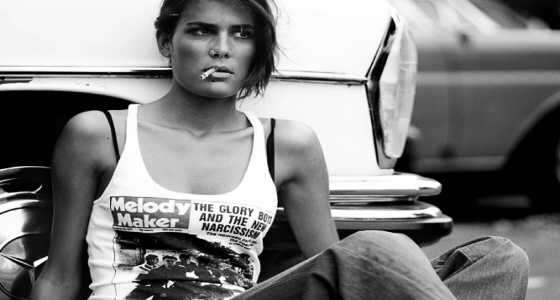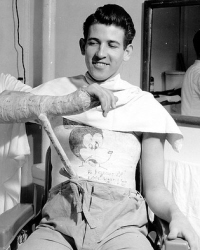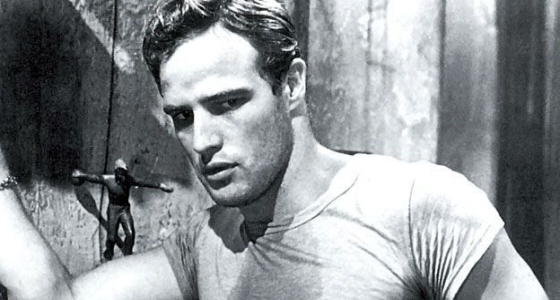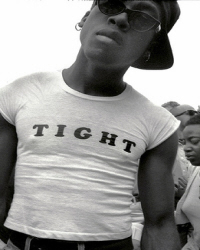
Antiquity
According to Ryan (2003) a t-shirt-like garment was used for millennia in Europe and has even been traced back though Roman times and on to ancient Egypt. This simple, ageless garment was the tunic, the true and most credible ancestor of the modern t-shirt. Clear depictions of it have been found in scenes carved in stone dating back at least three thousand years B.C. The tunic was such a practical and simple garment to make that its use spread throughout the civilized world, making it a standard for thousands of years. In more northern climes, its sleeves were almost always long and the "shirt" itself often reached to the ground, looking less like a t-shirt of today. Back in torrid heat of Egypt, however, the short-sleeve tunic was often waist length and made of cotton or linen, appearing quite like a modern t-shirt, though much rougher in feel and appearance
1914-1918
The modern phenomenon is thought to have been started with sailors.
In 1913 the US Navy issued new underwear to be worn under their V-necked uniforms. The short sleeved vet had a "crew" neckline (crew neck) with a vaguely "T"-shaped silhouette (T-shirt). During the Great War, when the US soldiers (Doughboys) saw their French counterparts wearing comfortable and lightweight cotton undershirts they were envious. The French simmet was eminently suited to the hot and humid summers and compared to their woolen efforts were cooler and more comfortable. The French ”T” shirts were eagerly taken back to the US as War souvenirs. "T-Shirt" become an official addition to the American English language soon after. Soon after the US armed services included the T-Shirt as standard issue underwear.
 1939-1945
1939-1945In World War II millions of serving men were issued with standard issue short sleeve, Mark 1Ts. These were based on the Navy’s newer less expensive T shirt which was called ‘skivvies’. Propaganda movies showing the GI's in their t-shirts became common fair for the home front. This flaunted dress codes and trilled the audience. The T-shirt had become by the end of the war a garment capable of displaying class, sexual orientation, and cultural affiliation. Like the high heeled shoe two decades before, it was a stereotype in search of a celluloid hero.
1950s
By the time of the Korean War, millions of young men in civilian life wore t-shirts as the fashion spread to the general population of young men. T-Shirts soon were seen on the screen by earthy characters and macho types, typified by John Wayne, Marlon Brandon and James Dean. Public viewing of civilian men in their underwear shocked American audiences and when Marlon Brando’s portrayal of Stanley Kowalski in ‘A streetcar named desire’ had his t-shirt ripped from his body on national TV (1951), it was considered very risqué. By the time he appeared in the Wild One (1953), the image of Brando in a t-shirt became the icon to every juvenile delinquent. Later when James Dean wore a T shirt in Rebel Without a Cause (1955) and Elvis Presley appeared in his t-shirt the image was softened and became all the more popular. By the end of the 60s girls started to wear T shirts and Jean Seberg crashed the scene of the screen in 1959 in a film called ‘A Bout de Souffle’ (Breathless). She wore a T shirt with the words ‘Herald Tribune’, emblazoned across it. There were only a few made and it quickly became very "in" among the ‘peppermint crowd’ taking the t-shirt into mainstream fashion.
1960s
By the 60s, tie dying and screen-printing techniques had improved to make basic cotton T-Shirt a fashion item with more appeal. Advances in printing and dying allowed more variety with the Tank Top, Muscle Shirt, Scoop Neck, V-Neck, and Sweatshirt all variations of the T-Shirt. Cotton T-Shirts were inexpensive and could be adjusted to reflect personal styles. The new political awareness amongst the protesting Hippies took on the Establishment (e.g. Easy Rider -1969) and made the T-shirt the graffiti wall of clothing. The first corporate-advertising tee was Budweiser and featured a can of Bud on the company's T-shirts. Companies gave away tees emblazoned with their corporate logos just for free advertising. Some designs such as the CND symbol and Playboy logo, became a matter of cool and hipness. Rock bands were quick to develop the souvenir Tour tee. All were avidly worn by the young ones.

1970s
Come the 70s, came the Sexual Revolution and wet tees and visibly erect nipples epitomized by Jacqueline Bisset in The Deep (1977). When t-shirt could advertise, brag, inform, shock, bewilder and exhibit whatever imagination could invent the flood gats were open and the T shirt became ubiquitous. As a blank canvas, it was limited only by imagination and technology. T shirts became throw away fashion but when professional sports caught on, market opportunities of the officially licensed T-Shirt became hot merchandise. The T shirt was becoming too respectable until Vivian Westwood and Malcolm Maclaren set new standards of social debauchery for youth and introduced of the designer tee with sex on its mind. Enter the punk generation where absolutely everything was worn on the tee. This include food, vomit to debased slogans so beloved by the social reprobates.
1980s
No place for T shirts in the flamboyant New Romantic era but when Frankie put the ‘F’ Word on their T Shirts, the uniform of rebellious youth was back with a vengeance. Yuppies brought gentrification and the dress conscious casuals wore designer tees by Armani where artwork symbolized the cultural and social norms. The appearance of youth with no visible means of earning, dressed in ultra expensive clothing underpinned the sinister antisocial lifestyle of the drug generation.
1990s
Sophisticated types wore androgogenous styles, not seen since the unisex fashion of the late 60s and early 70s. No sooner had the decade started however than an antifashion subculture developed. Grunge reveled in neopunk and the cotton Tee shirt was back. Goths, punks, and heavy metal have all had their fair share of shocking Ts but it was the Thrashers (SK8ers) who really popularized the new wave T shorts with their association with surfie gear sold in niche stores.
2000s
French Connection UK’s logo FCUK scored across a designer T shirt scarcely raises an eyebrow. So the T shirt has had to evolve to shock and the greatest innovation since tie dying has come via the urban graphittists and the Afro-American preoccupation of hip hop. Hooded tees are the perfect fashion for urban sport both for practical reasons (warmth) as well as the nefarious activities associated with the culture (preventing detection). For half a century T-shirts have never lost their ability to shock, or at least annoy.
 References
ReferencesGrey I Tee-Construction a brief history of the T-shirt
Ryan D. (2003) Short (but Authoritative) History of the T-shirt
Article Kippen C. 2013 Cameron K's blog Retrieved from
Cameron K's Blog
Many Thanks for allowing ZANI to reproduce this article





